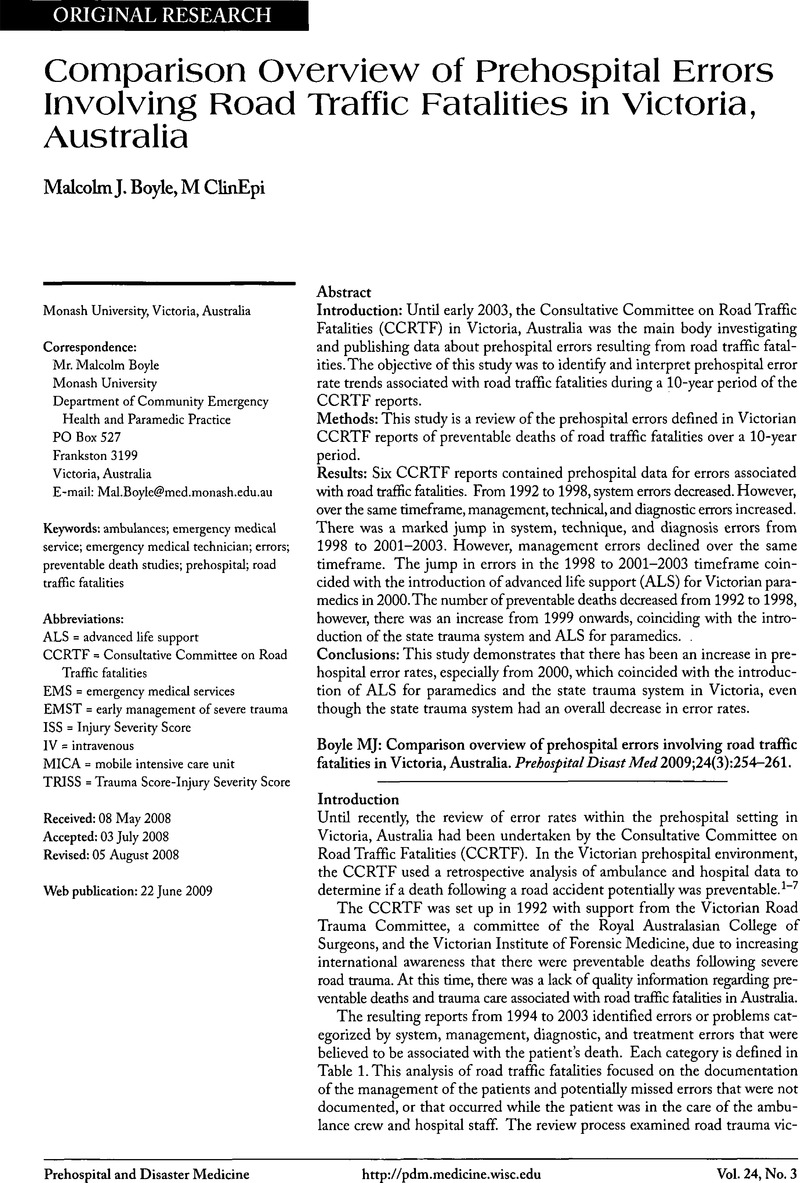No CrossRef data available.
Article contents
Errors at the Roadside: A Critical Time to Monitor
Published online by Cambridge University Press: 28 June 2012
Abstract
An abstract is not available for this content so a preview has been provided. Please use the Get access link above for information on how to access this content.

- Type
- Editorial Comments
- Information
- Copyright
- Copyright © World Association for Disaster and Emergency Medicine 2009
References
1.O'Connor, RE, Slovis, CM, Hunt, RC, Pirrallo, RG, Sayre, MR: Eliminating errors in emergency medical services: realities and recommendations. Prehosp Emerg Care 2002;6(1):107–113.CrossRefGoogle ScholarPubMed
2.Boyle, M, Archer, F, Macdonald, R: Incident Monitoring: A Review of the Literature and Development of a Pre-hospital Model. Melbourne: Monash University, 2002.Google Scholar
3.Pointer, JE, Osur, MA: EMS quality assurance: A computerized incident reporting system. J Emerg Med 1987;5(6):513–517.CrossRefGoogle ScholarPubMed
4.Brennan, TA, Leape, LL: Adverse events, negligence in hospitalized patients: Results from the Harvard Medical Practice Study. Perspect Healthc Risk Manage 1991;11(2):2–8.Google Scholar
5.Wilson, RM, Runciman, WB, Gibberd, RW, Harrison, BT, Newby, L, Hamilton, JD: The quality in Australian health care study. Med J Aust 1995;163(9):458–471.CrossRefGoogle ScholarPubMed
6.Wolff, AM, Bourke, J: Detecting and reducing adverse events in an Australian rural base hospital emergency department using medical record screening and review. Emerg Med J 2002;19(1):35–40.CrossRefGoogle Scholar
7.Thomas, AN, Pilkington, CE, Greer, R: Critical incident reporting in UK intensive care units: A postal survey. J Eval Clin Pract 2003;9(1):59–68.CrossRefGoogle ScholarPubMed
8.Thomas, EJ, Studdert, DM, Burstin, HR, Orav, EJ, Zeena, T, Williams, EJ, Howard, KM, Weiler, PC, Brennan, TA: Incidence and types of adverse events and negligent care in Utah and Colorado. Med Care 2000;38(3):261–271.Google Scholar
9.Donald, M, Paterson, B: Introduction of an electronic debrief and governance tool in prehospital care. Emerg Med J 2007;24(5):363–366.CrossRefGoogle ScholarPubMed
10.Fairbanks, RJ, Crittenden, CN, O'Gara, KG, Wilson, MA, Pennington, EC, Chin, NP, Shah, MN: Emergency medical services provider perceptions of the nature of adverse events and near-misses in out-of-hospital care: An ethnographic view. Acad Emerg Med 2008;15(7):633–640.CrossRefGoogle ScholarPubMed
11.Stella, J, Davis, A, Jennings, P, Bartley, B: Introduction of a prehospital critical incident monitoring system—Pilot project results. Prehospital Disast Med 2008;23(2):154–160.Google Scholar
12.Aufderheide, TP, Pirrallo, RG, Yannopoulos, D, Klein, JP, von Briesen, C, Sparks, CW, Deja, KA, Conrad, CJ, Kitscha, DJ, Provo, TA, Lurie, KG: Incomplete chest wall decompression: A clinical evaluation of CPR performance by EMS personnel and assessment of alternative manual chest compression-decompression techniques. Resuscitation 2005;64(3):353–362.Google Scholar
13.Bair, AE, Smith, D, Lichty, L: Intubation confirmation techniques associated with unrecognized non-tracheal intubations by pre-hospital providers. J Emerg Med 2005;28(4):403–407.CrossRefGoogle ScholarPubMed
14.Boyle, MJ: An overview of prehospital erros involving road traffic fatalities in Victoria, Australia. Prehospital Disast Med 2009;24(3):218–226.CrossRefGoogle Scholar
15.McDermott, FT, Cooper, GJ, Hogan, PL, Cordner, SM, Tremayne, AB: Evaluation of the prehospital management of road traffic fatalities in Victoria, Australia. Prehospital Disast Med 2005;20(4):219–227.CrossRefGoogle ScholarPubMed
16.Kelly, AM, Epstein, J: Preventable death studies: An inappropriate tool for evaluating trauma systems. Aust N Z J Surg 1997;67(9):591–592.Google Scholar
17.McDermott, FT, Cordner, SM, Cooper, DJ, Winship, VC, Consultative Committee on Road Traffic Fatalities in Victoria: Management deficiencies and death preventability of road traffic fatalities before and after a new trauma care system in Victoria, Australia. J Trauma 2007;63(2):331–338.Google ScholarPubMed
18.Leonard, M, Graham, S, Bonacum, D: The human factor: The critical importance of effective teamwork and communication in providing safe care. Qual Saf Health Care 2004;13(Suppl 1):i85–i90.CrossRefGoogle ScholarPubMed
19.Barach, P, Small, SD: Reporting and preventing medical mishaps: Lessons from non-medical near miss reporting systems. BMJ 2000;320(7237):759–763.CrossRefGoogle ScholarPubMed


